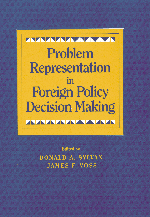Book contents
- Frontmatter
- Contents
- List of Contributors
- Part I Introducing Problem Representation
- Part II Overarching Conceptual Issues
- 3 The Interpretation of Foreign Policy Events: A Cognitive Process Theory
- 4 Problem Identification in Sequential Policy Decision Making: The Re-representation of Problems
- 5 Collective Interpretations: How Problem Representations Aggregate in Foreign Policy Groups
- 6 Image Change and Problem Representation after the Cold War
- Part III Empirical Analysis
- Part IV Conclusion
- Index
4 - Problem Identification in Sequential Policy Decision Making: The Re-representation of Problems
from Part II - Overarching Conceptual Issues
Published online by Cambridge University Press: 12 October 2018
- Frontmatter
- Contents
- List of Contributors
- Part I Introducing Problem Representation
- Part II Overarching Conceptual Issues
- 3 The Interpretation of Foreign Policy Events: A Cognitive Process Theory
- 4 Problem Identification in Sequential Policy Decision Making: The Re-representation of Problems
- 5 Collective Interpretations: How Problem Representations Aggregate in Foreign Policy Groups
- 6 Image Change and Problem Representation after the Cold War
- Part III Empirical Analysis
- Part IV Conclusion
- Index
Summary
It is our contention that most foreign policy problems continue over an extended period of time and that policy makers often find themselves returning again and again to the task of coping with an issue they have addressed before. Problems that have been addressed on a number of previous occasions will present a different decision task than those newly faced. Our goal here is to continue our analysis of sequential decision making in foreign policy groups, building on the model outlined in Hermann and Billings (1993). We focus on one specific piece of the overall puzzle of sequential decision making - the conditions that foster a reexamination of the nature of the problem. We assume that the way in which the problem is represented affects much of the subsequent decision-making process, along with the resulting action. Accordingly, a complete model of sequential decision making requires an understanding of how and why problems may become “re-represented.”
Despite the frequency of sequential decision making in the actual conduct of foreign policy, many analytic studies of decision are narrowly constructed episodes that focus on one major decision or a set of decisions that occur in only a short period of time. A study typically characterizes a challenge facing a government and the manner by which it decides on a response. Laboratory studies on sequential decision making are also rare.
Of course, there are exceptions. Game theory has explored the implications of iterative games (e.g., Axelrod 1984), and cybernetic models have featured feedback loops (e.g., Steinbruner 1974). Psychologists have explored the escalation of commitment (e.g., Staw 1981; Brockner 1992), frequently invoking American decision making on Vietnam as an example. Recently, several researchers have begun to examine the effects of past decisions on decision biases (e.g., Kleinmutz 1985) and risk taking (e.g., Hollenbeck, lIgen, Philips, and Hedlund 1994; Thaler and Johnson 1990), often using the term dynamic decision making to refer to a sequence of decisions on the same issue. But the vast majority of decision-making studies have keyed on a single decision or episode. A recent review (Stevenson, Busemeyer, and Naylor 1990) concluded that sequential decision making is one of the most complex and least understood topics in the literature on decision making.
- Type
- Chapter
- Information
- Problem Representation in Foreign Policy Decision-Making , pp. 53 - 79Publisher: Cambridge University PressPrint publication year: 1998
- 11
- Cited by



